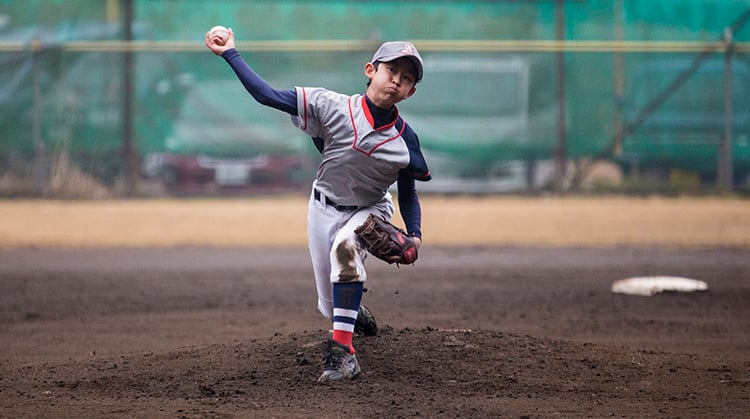
Pitcher's elbow, also known as medial epicondyle apophysitis, is a common injury that occurs among young baseball players. Caused by "overuse" and "repetitive motion," pitcher's elbow causes pain and swelling inside of the elbow, can limit one's range of motion, and will limit or prevent the ability to throw a ball.
Causes
The forceful and repetitive nature of overhand throwing for baseball players (pitchers in particular) can cause inflammation of the growth plate inside the throwing elbow, resulting in pitcher's elbow. Adolescent baseball players are most likely to experience this injury because their elbow structure (including their bones, growth plates, and ligaments) is not fully mature or developed.
The following risk factors contribute to pitcher's elbow:
- Age. Young baseball players (particularly those between the ages of 9 and 14 years) are at greater risk because their elbow joints are not fully developed. Less mature bones, looseness of the ligaments, open growth plates, and undeveloped musculature are common in youth pitchers and predispose them to overuse injuries.
- Pitching too many games. The number of games pitched should be carefully monitored and the league's pitch count rules followed. Research has proven that overuse in baseball contributes to injuries such as pitcher's elbow. Specifically, there is evidence it can occur over the course of a game (pitching more than than 75 pitches per game), per season (pitching more than 1,000 pitches per season), or per year (pitching more than 3,000 pitches per year. Also, it is advised that pitching not occur for greater than 8 months of the year. If pain occurs before the pitch count limit is reached, the player should stop immediately. Additionally, pitching should be halted if fatigue is experienced during the game. Rotating pitchers within games is a good idea to ensure each pitcher gets adequate rest.
- Curveballs and breaking pitches. Likely due to poor pitch mechanics, both of these types of pitches appear to put more stress on the growth plate than other pitches. These should be limited, especially in players between the ages of 9 and 14 years.
- Improper mechanics. Improper throwing mechanics can put undue force on the elbow joint. Proper throwing mechanics can help a young player avoid unnecessary injury and develop proper technique that improves their game. Your coach or other qualified instructors can be used as a resource to ensure you have learned proper mechanics.
More about pitch count
- No multiple pitching appearances in a single game. Your child should not make more than 1 pitching appearance in 1 game (or pitch, change positions, then pitch again).
- No circumventing pitch count rules by pitching in multiple leagues. Most youths now play in multiple leagues and the number of pitches can only be tracked for each individual league. It is important to avoid violating the pitch count restrictions by pitching in multiple leagues.
- No pitching at home after having pitched in a game. To limit the number and amount of overall pitches thrown, players are advised not to pitch at home after having pitched in a game.
- Get appropriate rest between pitching performances. See recommended pitch count rules.
How a Physical Therapist Can Help
Physical therapists are experts in restoring and improving mobility and motion in people's lives, and eliminating pain. For young baseball players, this means a physical therapist will work with you to help prevent pitcher's elbow, and recover safely if it does occur.
In addition to following the guidelines for pitch counts and recommendations for rest, a physical therapist will help baseball players prevent the occurrence of pitcher's elbow by teaching them stretching and strengthening exercises that are individualized to their specific needs. Everybody is different, which means pitcher's elbow may occur for different reasons for each person.
A physical therapist will help a player recover by designing a personalized treatment plan to regain range of motion, flexibility, and strength.
Physical therapists are movement experts. They improve quality of life through hands-on care, patient education, and prescribed movement. You can contact a physical therapist directly for an evaluation. To find a physical therapist in your area, visit Find a PT.


